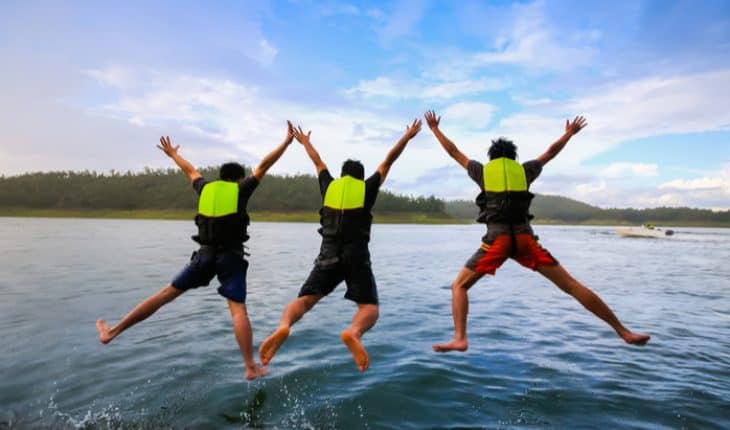There is nothing more refreshing than a cool dip on a warm day. However, the RNLI, are highlighting the dangers of cold water shock that can make you unable to breathe if you suddenly enter cold water, either deliberately or from falling in. Their clear advice has already saved numerous lives and it is a message they are keen for people to share:
Because of the contrasting air and water temperature, many people who fall into the sea, canal or lake are at high risk of suffering cold water shock.
Cold Water Shock
Cold water shock causes you to gasp uncontrollably and panic, which often leads to drowning. The shock of entering the water triggers the automatic flight and fright response resulting in panic and confusion, putting additional strain on the heart, further lowering skin temperature by shutting down the peripheral circulation. Thrashing around trying to swim will encourage air to escape from clothing, thereby reducing buoyancy and making it harder to float.
The RNLI Respect The Water Campaign urges people to avoid gasping, thrashing or swimming hard and to remain as calm as possible, turn onto their back and float instead.
Floating
Floating offers an opportunity to catch your breath; allowing the effects of cold water shock to pass. This should take no more than about 90 seconds. Do not worry if you are wearing clothes and shoes as these will remain buoyant and help you to float in the initial minute it takes you to regain control of your breathing.
Once you have control of your breath, you can swim to safety, call for help or continue to float until help arrives.
Understanding this approach and floating rather than panicking will greatly increase your chances of survival.
Control Your Breathing
The key message is to do as little as possible until you can control your breathing.
The RNLI are urging people to practise floating and share this important message as it has been proven to save lives.
Five steps to float:
- Fight your instinct to thrash around
- Lean back, extend your arms and legs
- If you need to, gently move them around to help you float
- Float until you can control your breathing
- Only then, call for help or swim to safety
The RNLI also advises if you see someone in difficulties in the water to fight the urge to go in and try and rescue them. Instead call 999 and ask for the Coastguard. Or call 112.
It is worth remembering too, that the sudden and extreme contrast between warm air and cold water, can lead to cardiac arrest. Consequently, it is strongly advised not to jump or dive straight into cold water on a hot day.
that can make you unable to breathe if you suddenly enter cold water, either deliberately or from falling in. Their clear advice has already saved numerous lives and it is a message they are keen for people to share:
Because of the contrasting air and water temperature, many people who fall into the sea, canal or lake are at high risk of suffering cold water shock.
Cold Water Shock
Cold water shock causes you to gasp uncontrollably and panic, which often leads to drowning. The shock of entering the water triggers the automatic flight and fright response resulting in panic and confusion, putting additional strain on the heart, further lowering skin temperature by shutting down the peripheral circulation. Thrashing around trying to swim will encourage air to escape from clothing, thereby reducing buoyancy and making it harder to float.
The RNLI Respect The Water Campaign urges people to avoid gasping, thrashing or swimming hard and to remain as calm as possible, turn onto their back and float instead.
Floating
Floating offers an opportunity to catch your breath; allowing the effects of cold water shock to pass. This should take no more than about 90 seconds. Do not worry if you are wearing clothes and shoes as these will remain buoyant and help you to float in the initial minute it takes you to regain control of your breathing.
Once you have control of your breath, you can swim to safety, call for help or continue to float until help arrives.
Understanding this approach and floating rather than panicking will greatly increase your chances of survival.
Control Your Breathing
The key message is to do as little as possible until you can control your breathing.
The RNLI are urging people to practise floating and share this important message as it has been proven to save lives.
Five steps to float:
Fight your instinct to thrash around
Lean back, extend your arms and legs
If you need to, gently move them around to help you float
Float until you can control your breathing
Only then, call for help or swim to safety
The RNLI also advises if you see someone in difficulties in the water to fight the urge to go in and try and rescue them. Instead call 999 and ask for the Coastguard. Or call 112.
It is worth remembering too, that the sudden and extreme contrast between warm air and cold water, can lead to cardiac arrest. Consequently, it is strongly advised not to jump or dive straight into cold water on a hot day.
- What is a seizure? - 13th March 2025
- Febrile Convulsions and Seizures in Children - 13th March 2025
- Why women are less likely to receive CPR or survive cardiac arrest - 6th March 2025







